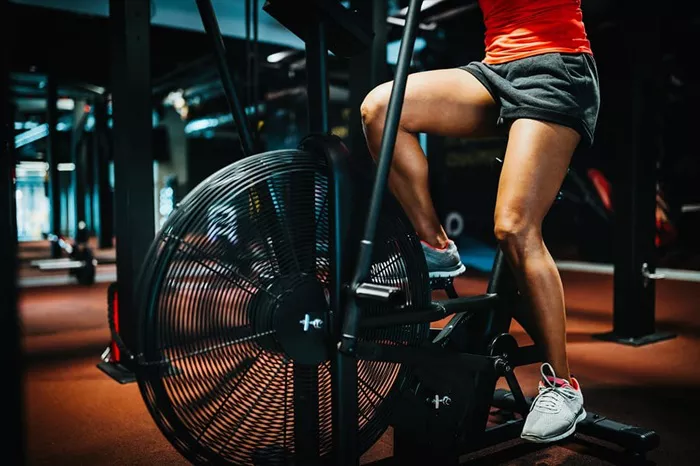In the realm of fitness equipment, the air bike stands out as a versatile and effective tool for improving cardiovascular health and overall fitness. With its unique design and functionality, the air bike offers a challenging workout experience that targets multiple muscle groups while providing a low-impact exercise option. In this comprehensive guide, we will explore what an air bike is, how it works, its benefits, and how to incorporate it into your fitness routine for optimal results.
Understanding the Air Bike
What is an Air Bike?
An air bike, also known as a fan bike or assault bike, is a stationary exercise bike equipped with a large fan in place of a traditional flywheel. The fan is powered by the user’s pedaling motion, creating resistance that increases with speed. Unlike traditional exercise bikes that rely on magnetic or friction resistance, air bikes provide an unlimited resistance potential, making them suitable for users of all fitness levels.
How Does an Air Bike Work?
The operation of an air bike is relatively simple yet highly effective. As the user pedals, the motion turns the fan blades, which create resistance by displacing air. The harder and faster the user pedals, the greater the resistance becomes. This dynamic resistance mechanism allows users to control the intensity of their workout simply by adjusting their pedaling speed.
Key Features of an Air Bike
Large Fan: The centerpiece of an air bike is its large fan, which provides resistance based on the user’s pedaling effort.
Adjustable Seat and Handlebars: Most air bikes feature adjustable seats and handlebars to accommodate users of different sizes and preferences.
LCD Console: Many air bikes come equipped with an LCD console that displays metrics such as time, distance, calories burned, and speed, allowing users to track their progress and performance.
Dual-Action Arms: Some air bikes feature movable handlebars or dual-action arms that engage the upper body muscles, providing a full-body workout experience.
Benefits of Using an Air Bike
Full-Body Workout
One of the primary benefits of using an air bike is its ability to provide a full-body workout. Unlike traditional stationary bikes that primarily target the lower body, air bikes engage both the upper and lower body muscles simultaneously. The pushing and pulling motion of the handlebars engages the arms, shoulders, and core muscles, while the pedaling action works the legs and glutes.
High-Intensity Interval Training (HIIT)
Air bikes are well-suited for high-intensity interval training (HIIT), a workout strategy that alternates between short bursts of intense exercise and brief periods of rest or lower-intensity activity. HIIT workouts on an air bike can help improve cardiovascular fitness, increase calorie burn, and boost metabolism in a relatively short amount of time.
Low-Impact Exercise Option
Despite its high-intensity nature, the air bike offers a low-impact exercise option that is gentle on the joints. Unlike activities such as running or jumping, which can place stress on the knees and ankles, the smooth, circular motion of pedaling on an air bike minimizes impact, making it suitable for individuals with joint pain or mobility issues.
Calorie Burn and Weight Loss
Due to its ability to provide both cardiovascular and strength training benefits, the air bike is an effective tool for calorie burn and weight loss. A vigorous workout on an air bike can torch calories at a rapid rate, helping users achieve their weight loss goals more efficiently when combined with a balanced diet and lifestyle.
Tips for Using an Air Bike Effectively
Start Slow and Gradually Increase Intensity
If you’re new to using an air bike, start with a low resistance level and a moderate pace to familiarize yourself with the equipment and proper form. As you become more comfortable, gradually increase the resistance and intensity of your workouts to challenge yourself and continue making progress.
Focus on Proper Form
Maintaining proper form is essential for getting the most out of your air bike workouts while minimizing the risk of injury. Keep your back straight, shoulders relaxed, and core engaged throughout the workout. Ensure that your feet are securely positioned on the pedals, and use a smooth, controlled pedaling motion.
Incorporate Interval Training
Take advantage of the air bike’s versatility by incorporating interval training into your workouts. Alternate between periods of high-intensity effort, where you pedal as fast and as hard as you can, and periods of recovery or lower-intensity pedaling. Experiment with different work-to-rest ratios to find what works best for you.
Use the Handlebars Wisely
Engage your upper body muscles by actively pushing and pulling on the handlebars as you pedal. Coordinate your arm and leg movements to maximize the effectiveness of your workout. Experiment with different hand positions and grip styles to target different muscle groups and add variety to your workouts.
Sample Air Bike Workouts
Beginner Workout:
Warm-Up: 5 minutes of easy pedaling at a moderate pace.
Main Workout: Alternate between 30 seconds of high-intensity pedaling (as fast as you can) and 60 seconds of moderate-intensity pedaling (at a comfortable pace) for a total of 20 minutes.
Cool Down: 5 minutes of easy pedaling at a slow pace, focusing on deep breathing and stretching.
Advanced Workout:
Warm-Up: 5 minutes of easy pedaling at a moderate pace.
Main Workout: Perform 10 rounds of the following circuit:
20 seconds of maximum effort pedaling
40 seconds of recovery pedaling (at a slow pace)
Cool Down: 5 minutes of easy pedaling at a slow pace, followed by stretching exercises for the major muscle groups.
Incorporating the Air Bike into Your Fitness Routine
Stand-Alone Workouts
The air bike can serve as the centerpiece of a stand-alone cardio workout routine. Incorporate it into your routine as a primary cardiovascular exercise, aiming for 20-30 minutes of moderate to high-intensity pedaling, 3-5 times per week.
Cross-Training
The versatility of the air bike makes it an excellent option for cross-training. Use it as part of a circuit training workout, alternating between different exercises such as strength training, bodyweight exercises, and flexibility exercises to create a well-rounded fitness routine.
Active Recovery
On days when you’re not doing intense workouts, use the air bike for active recovery. Pedal at a low to moderate intensity for 20-30 minutes to promote blood flow, reduce muscle soreness, and aid in recovery from more challenging workouts.
Conclusion
The air bike is a valuable addition to any fitness routine, offering a challenging yet low-impact workout experience that targets multiple muscle groups and improves cardiovascular health. Whether you’re a beginner looking to improve your fitness level or an experienced athlete seeking to enhance your performance, the air bike has something to offer. By understanding how to use the air bike effectively, incorporating it into your fitness routine, and following best practices for workouts, you can reap the benefits of this versatile piece of equipment and achieve your fitness goals.
[inline_related_posts title=”You Might Be Interested In” title_align=”left” style=”list” number=”6″ align=”none” ids=”8747,8681,8678″ by=”categories” orderby=”rand” order=”DESC” hide_thumb=”no” thumb_right=”no” views=”no” date=”yes” grid_columns=”2″ post_type=”” tax=””]

































